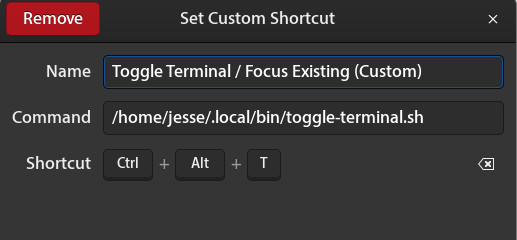Ubuntu Single Instance Hotkeys
Single Load Hotkeys in Ubuntu
Before we begin, make sure to remove any default shortcuts you may have. I’ll set my hotkey to First, install wmctrl with the following command If you have multiple terminals installed, this setup will open a new instance of your default terminal, and if there is an instance already open, it will bring that to focus rather than creating a new one. If you want to change your default terminal emulator, use:CTRL + ALT + T to load the terminator emulator. We’ll use wmctrl (Window Manager Control) and a Bash script to execute this function. Finally, we’ll set the custom keybinding in the system settings.Installing wmctrl
sudo apt instlal wmctrl -y
# If you want to change your default emulation
sudo update-alternatives --config x-terminal-emulator
Writing our Bash Script
Since you may be using different terminal emulators, this script will check for your system's default terminal. Below is an example that includes several terminal options. You may need to modify two parts of the script indicated as [1] and [2] if you are adding another. The comments provide instructions on how to find a Bash Script Example
WM_CLASS.#!/bin/bash
# Find the default terminal you have set so you don't have to rewrite this script
# The echo output of this function is stored in a DEFAULT_TERMINAL variable.
get_default_terminal() {
# -------------------------------------
# [1] Add any additional terminals here
# -------------------------------------
local terminals=("x-terminal-emulator" "gnome-terminal" "terminator", "warp", "wave")
for terminal in "${terminals[@]}"; do
if command -v "$terminal" > /dev/null; then
echo "$terminal" # Places it in DEFAULT_TERMINAL below
return # Exit function after finding the terminal
fi
done
echo "gnome-terminal" # Fallback
}
DEFAULT_TERMINAL=$(get_default_terminal)
# echo "Using terminal: $DEFAULT_TERMINAL"
# --------------------------------------------
# [2] Add any WM_CLASS of your terminals here
# --------------------------------------------
# [help] To find a Window Class name run this:
# $ xprop WM_CLASS | awk -F'"' '{print $2"."$4}'
TERMINAL_CLASSES="gnome-terminal.Terminal|terminator.Terminator|x-terminal-emulator.X-terminal-emulator|dev.warp.Warp.dev.warp.Warp|wave.Wave"
# Check for an existing instance
WINDOW_ID=$(wmctrl -lx | grep -E "$TERMINAL_CLASSES" | awk '{print $1}')
# echo "Window ID found: $WINDOW_ID"
if [ -n "$WINDOW_ID" ]; then
# echo "Focusing terminal window: $WINDOW_ID"
wmctrl -ia "$WINDOW_ID"
else
# echo "No terminal window found. Launching a new one."
$DEFAULT_TERMINAL &
fi
Save Your File and Change Permissions
Save the script in your preferred location. For example, you can save it as ~/.local/bin/toggle-terminal.sh. Make sure to make it executable
chmod +x ~/.local/bin/toggle-terminal.sh
Set your Hotkey
Next, go to your Settings > Keyboard > View and Customize Shortcuts and Custom Shortcuts at the bottom. Add a new entry and point it to where you placed your file.

/home/jesse/.local/bin/toggle-terminal.sh
Try out your hotkey! If it doesn't trigger, I found that using ~/path/to/file.sh can be problematic; using the absolute path (e.g. /home/jesse/.local/bin/toggle-terminal.sh) usually works better.
If you need to debug any issues, uncomment the echo statements in the script and run it from a terminal that isn't your default terminal to see the output.
To log any output from your script when you trigger the hotkey, change your hotkey setting in the GUI Custom Shortcuts to:
/home/user/file.sh > ~/debug-toggle.log &2>1
After triggering it, you can check the log with:
cat ~/debug-toggle.log
Hopefully this is useful!